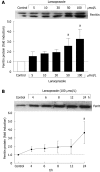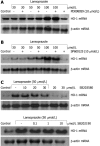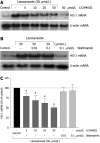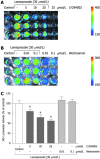Molecular mechanism and functional consequences of lansoprazole-mediated heme oxygenase-1 induction
- PMID: 19764090
- PMCID: PMC2747059
- DOI: 10.3748/wjg.15.4392
Molecular mechanism and functional consequences of lansoprazole-mediated heme oxygenase-1 induction
Abstract
Aim: To investigate the molecular mechanism and functional consequences of heme oxygenase-1 (HO-1) activation by lansoprazole in endothelial cells and macrophages.
Methods: Expression of HO-1 mRNA was analyzed by Northern blotting. Western blotting was used to determine the HO-1 and ferritin protein levels. NADPH-dependent reactive oxygen species (ROS) formation was measured with lucigenin-enhanced chemiluminescence. HO-1 promoter activity in mouse fibroblasts, stably transfected with a 15-kb HO-1 gene that drives expression of the reporter gene luciferase, was assessed using in vivo bioluminescence imaging.
Results: Lansoprazole increased HO-1 mRNA levels in endothelial cells and HO-1 protein levels in macrophages. In addition, lansoprazole-induced ferritin protein levels in both cell systems. Moreover, induction of the antioxidant proteins HO-1 and ferritin by lansoprazole was followed by a decrease in NADPH-mediated ROS formation. The radical scavenging properties of lansoprazole were diminished in the presence of the HO inhibitor, chromium mesoporphyrin IX. Induction of HO-1 gene expression by lansoprazole was not related to oxidative stress or to the activation of the mitogen-activated protein kinase pathway. However, the phosphatidylinositol 3-kinase inhibitor LY294002 showed a concentration-dependent inhibition of HO-1 mRNA and promoter activity.
Conclusion: Activation of HO-1 and ferritin may account for the gastric protection of lansoprazole and is dependent on a pathway blocked by LY294002.
Figures








Similar articles
-
Lansoprazole, a proton pump inhibitor, mediates anti-inflammatory effect in gastric mucosal cells through the induction of heme oxygenase-1 via activation of NF-E2-related factor 2 and oxidation of kelch-like ECH-associating protein 1.J Pharmacol Exp Ther. 2009 Oct;331(1):255-64. doi: 10.1124/jpet.109.152702. Epub 2009 Jul 23. J Pharmacol Exp Ther. 2009. PMID: 19628634
-
Statin-mediated cytoprotection of human vascular endothelial cells: a role for Kruppel-like factor 2-dependent induction of heme oxygenase-1.J Thromb Haemost. 2007 Dec;5(12):2537-46. doi: 10.1111/j.1538-7836.2007.02787.x. Epub 2007 Oct 8. J Thromb Haemost. 2007. PMID: 17927807
-
Cigarette smoke extract upregulates heme oxygenase-1 via PKC/NADPH oxidase/ROS/PDGFR/PI3K/Akt pathway in mouse brain endothelial cells.J Neuroinflammation. 2011 Aug 24;8:104. doi: 10.1186/1742-2094-8-104. J Neuroinflammation. 2011. PMID: 21861928 Free PMC article.
-
Heme oxygenase-1 is a novel target and antioxidant mediator of S-adenosylmethionine.Biochem Biophys Res Commun. 2008 Apr 18;368(4):937-41. doi: 10.1016/j.bbrc.2008.02.009. Epub 2008 Feb 12. Biochem Biophys Res Commun. 2008. PMID: 18275848
-
Heme oxygenase-1 gene activation by the NAD(P)H oxidase inhibitor 4-(2-aminoethyl) benzenesulfonyl fluoride via a protein kinase B, p38-dependent signaling pathway in monocytes.J Biol Chem. 2005 Jun 10;280(23):21820-9. doi: 10.1074/jbc.M502943200. Epub 2005 Apr 15. J Biol Chem. 2005. PMID: 15833736
Cited by
-
Heme oxygenase-1: a novel therapeutic target for gastrointestinal diseases.J Clin Biochem Nutr. 2011 Mar;48(2):126-33. doi: 10.3164/jcbn.10-61. Epub 2011 Feb 26. J Clin Biochem Nutr. 2011. PMID: 21373265 Free PMC article.
-
Association of atrial fibrillation and gastroesophageal reflux disease: Natural and therapeutic linkage of the two common diseases.J Arrhythm. 2018 Oct 12;35(1):43-51. doi: 10.1002/joa3.12125. eCollection 2019 Feb. J Arrhythm. 2018. PMID: 30805043 Free PMC article. Review.
-
The proton-pump inhibitor lansoprazole enhances amyloid beta production.PLoS One. 2013;8(3):e58837. doi: 10.1371/journal.pone.0058837. Epub 2013 Mar 8. PLoS One. 2013. PMID: 23520537 Free PMC article.
-
Lansoprazole protects hepatic cells against cisplatin-induced oxidative stress through the p38 MAPK/ARE/Nrf2 pathway.PLoS One. 2023 Jun 29;18(6):e0287788. doi: 10.1371/journal.pone.0287788. eCollection 2023. PLoS One. 2023. PMID: 37384717 Free PMC article.
-
Computational discovery of therapeutic candidates for preventing preterm birth.JCI Insight. 2020 Feb 13;5(3):e133761. doi: 10.1172/jci.insight.133761. JCI Insight. 2020. PMID: 32051340 Free PMC article.
References
-
- Das D, Bandyopadhyay D, Bhattacharjee M, Banerjee RK. Hydroxyl radical is the major causative factor in stress-induced gastric ulceration. Free Radic Biol Med. 1997;23:8–18. - PubMed
-
- Langman MJ, Brooks P, Hawkey CJ, Silverstein F, Yeomans N. Non-steroid anti-inflammatory drug associated ulcer: epidemiology, causation and treatment. J Gastroenterol Hepatol. 1991;6:442–449. - PubMed
-
- Konturek PC, Bielański W, Konturek SJ, Hahn EG. Helicobacter pylori associated gastric pathology. J Physiol Pharmacol. 1999;50:695–710. - PubMed
-
- Gisbert JP, González L, Calvet X, Roqué M, Gabriel R, Pajares JM. Proton pump inhibitors versus H2-antagonists: a meta-analysis of their efficacy in treating bleeding peptic ulcer. Aliment Pharmacol Ther. 2001;15:917–926. - PubMed
Publication types
MeSH terms
Substances
LinkOut - more resources
Full Text Sources

